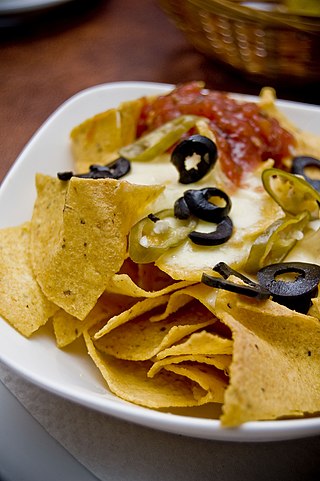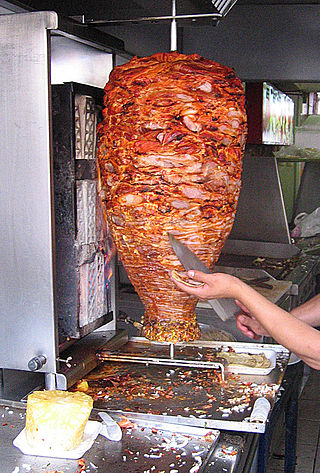Related Research Articles

An enchilada is a Mexican dish consisting of a corn tortilla rolled around a filling and covered with a savory sauce. Enchiladas can be filled with various ingredients, including meats, cheese, beans, potatoes, vegetables, or combinations. Enchilada sauces include chili-based sauces, such as salsa roja, various moles, tomatillo-based sauces, such as salsa verde, or cheese-based sauces, such as chile con queso.

In North America, a corn tortilla or just tortilla is a type of thin, unleavened flatbread, made from hominy, that is the whole kernels of maize treated with alkali to improve their nutrition in a process called nixtamalization. A simple dough made of ground, dried hominy, salt and water is then formed into flat discs and cooked on a very hot surface, generally an iron griddle called a comal.

Tostada is the name given to various dishes in Mexico and other parts of Latin America which include a toasted tortilla as the main base of their preparation.

Chilaquiles are a traditional Mexican breakfast dish consisting of corn tortillas cut into quarters and lightly fried.

Refried beans is a dish of cooked and mashed beans that is a traditional staple of Mexican and Tex-Mex cuisine, although each cuisine has a different approach when making the dish. Refried beans are also popular in many other Latin American countries. The English "refried beans" is a mistranslation, since the essence of "frijoles refritos" is the reheating and mashing of the beans.

Nachos is a Mexican culinary dish consisting of tortilla chips or totopos covered with cheese or cheese sauce, as well as a variety of other toppings and garnishes, often including meats, vegetables, and condiments such as salsa, guacamole, or sour cream. At its most basic form, nachos may consist of merely chips covered with cheese, and served as an appetizer or snack, while other versions are substantial enough as a main course. The dish was created by, and named after, Ignacio Anaya, who created it in 1941 for customers at the Victory Club restaurant in Piedras Negras, Coahuila.

The milanesa is a variation of the Lombard veal Milanese, or the Austrian Wiener Schnitzel, where generic types of meat breaded cutlet preparations are known as a milanesa.

Migas is a dish traditionally made from stale bread and other ingredients in Spanish and Portuguese cuisines. Originally introduced by shepherds, migas are very popular across the Iberian Peninsula, and are the typical breakfast of hunters at monterías in southern Spain.

Chicharrón is a dish generally consisting of fried pork belly or fried pork rinds. Chicharrón may also be made from chicken, mutton or beef.

Huevos rancheros is a breakfast egg dish served in the style of the traditional large mid-morning fare on rural Mexican farms.

Torta is a culinary term that can, depending on the cuisine, refer to cakes, pies, flatbreads, sandwiches, or omelettes.

New Mexican cuisine is the cuisine of the Southwestern US state of New Mexico. The region is primarily known for its fusion of Pueblo Native American cuisine with Hispano Spanish and Mexican cuisine originating in Nuevo México.

Al pastor, tacos al pastor, or tacos de trompo is a preparation of spit-grilled slices of pork originating in the Central Mexican region of Puebla and Mexico City, although today it is a common menu item found in taquerías throughout Mexico. The method of preparing and cooking al pastor is based on the lamb shawarma brought by Lebanese immigrants to the region. Al pastor features a flavor palate that uses traditional Mexican adobada (marinade). It is a popular street food that has spread to the United States. In some places of northern Mexico and coastal Mexico, such as in Baja California, taco al pastor is known as taco de trompo or taco de adobada.

Picadillo is a traditional dish in many Latin American countries including Puerto Rico and Cuba as well as the Philippines. It is made with ground meat, tomatoes, and also raisins, olives, and other ingredients that vary by region. It is often served with rice or used as a filling in dishes such as tacos, savory pastries or croquettes. The name comes from the Spanish word picar, meaning "to mince".

Chilean cuisine stems mainly from the combination of traditional Spanish cuisine, Chilean Mapuche culture and local ingredients, with later important influences from other European cuisines, particularly from Germany, the United Kingdom and France. The food tradition and recipes in Chile are notable for the variety of flavours and ingredients, with the country's diverse geography and climate hosting a wide range of agricultural produce, fruits and vegetables. The long coastline and the peoples' relationship with the Pacific Ocean add an immense array of seafood to Chilean cuisine, with the country's waters home to unique species of fish, molluscs, crustaceans and algae, thanks to the oxygen-rich water carried in by the Humboldt Current. Chile is also one of the world's largest producers of wine and many Chilean recipes are enhanced and accompanied by local wines. The confection dulce de leche was invented in Chile and is one of the country's most notable contributions to world cuisine.

Seven-layer salad is an American dish that includes a colorful combination of seven layers of ingredients: iceberg lettuce, tomatoes, cucumbers, onions, sweet peas, hard-boiled eggs, sharp cheddar cheese, and bacon pieces. The salad is topped with a mayonnaise-based dressing and sometimes sour cream is added. It is often served in a glass bowl or large pan so the layers can be observed. The dish is often associated with potlucks, picnics, and barbecues, where a large gathering of people takes place and many people need to be fed. There are many variants of the seven-layer salad and it can be made with additional layers, making it an eight-layer salad instead.

Pan de cazón is a casserole dish in Mexican cuisine that is prepared in the style of lasagna using layered tortillas with shark meat such as dogfish shark, black beans or refried black beans and spiced tomato sauce with habanero. It has been described as a specialty dish of the state of Campeche, Mexico.
References
- Del Castillo, María. (1966). Cocina mexicana. Ed. Olimpo.









